Football (ball) facts for kids
A football is a special ball filled with air. It's used to play many different sports, all called "football"! In most of these games, teams try to score points by getting the ball into a special area called a goal. Each team tries to move the ball in opposite directions across the playing field of play.
Long ago, the first footballs were made from natural materials, like an inflated pig bladder (which is why some people still call a football a "pigskin"). These bladders were often put inside a leather cover. Today, footballs are designed by experts. They have rubber or plastic bladders inside and often plastic covers. Different sports and leagues use different types of footballs, but they all have one of these basic shapes:
- A sphere (round ball): Used in association football (soccer) and Gaelic football.
- A prolate spheroid (an oval or egg shape):
- With rounded ends: Used in rugby and Australian football.
- With more pointed ends: Used in gridiron football.
The exact shape and how footballs are made are usually part of the rules for each sport.
The oldest football ever found was discovered in the roof of Stirling Castle in Scotland in 1981. It's believed to have been made around 1550! This old ball is made of leather (maybe from a deer) and a pig's bladder. It's about 14 to 16 cm (5.5 to 6.3 in) wide and weighs about 125 g (4.4 oz). You can see it today at the Smith Art Gallery and Museum in Stirling.
Contents
Association Football (Soccer) Balls
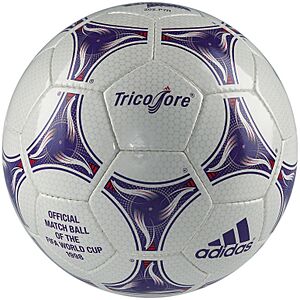
In soccer, Law 2 says the ball must be a round, air-filled sphere. It should be about 68 to 70 cm (27 to 28 in) around and weigh between 410 and 450 g (14 to 16 oz). It needs to be inflated to a certain pressure and covered in leather or another good material. The weight mentioned is for a dry ball. Older balls used to get much heavier if they got wet during a game!
There are many kinds of soccer balls for different uses. These include training balls, match balls, professional match balls, and special balls for beach, street, or indoor soccer.
Most modern soccer balls are made from 32 panels of waterproof leather or plastic stitched together. These panels are 12 regular pentagons (5-sided shapes) and 20 regular hexagons (6-sided shapes). This 32-panel design makes the ball round because the air pressure inside pushes the faces outwards. The first ball with this design was sold by Select in Denmark in the 1950s. It became popular around the world with the Adidas Telstar, the official ball of the 1970 World Cup. This design is often used to describe other cool shapes like carbon buckyballs and geodesic domes.
Gridiron Football (American and Canadian) Balls
In the United States and Canada, "football" usually means the oval-shaped ball used in American or Canadian football. Professional and college games require balls made of cow hide leather. Balls for fun games or youth leagues might be made of rubber or plastic. Since 1941, Horween Leather Company has been the only supplier of leather for National Football League (NFL) footballs.
Leather panels are usually tanned to a natural brown color. This is typically required in professional and college games. Some manufacturers make leather that feels "tacky" for a better grip, even when wet. In the past, white footballs were used for night games so players could see them better. But now, with good stadium lights, this isn't needed.
Most levels of play (but not the NFL) have white stripes painted on each end of the ball. These stripes help with visibility at night and also help tell college footballs apart from pro footballs. The NFL did try white-striped footballs once in Super Bowl VIII.
In the CFL, the stripes go all the way around the ball. Other leagues have used different colors or designs, like lime-green stripes or black balls with red lines. The XFL of 2020 uses standard brown balls but with "X" markings instead of stripes.
Footballs used in gridiron games have pointed ends. This shape is often credited to an official named Shorty Ray. He introduced the new ball in 1934 to make the forward pass easier and more exciting.
Australian Rules Football Balls
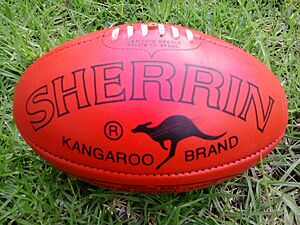
The football used in Australian football is similar to a rugby ball. It's usually a bit smaller and more rounded at the ends, but it looks longer compared to its width than a rugby ball. A regulation ball is about 720 to 730 mm (28 to 29 in) around its length and 545 to 555 mm (21.5 to 21.9 in) around its width. It's inflated to a pressure of 62 to 76 kPa (9.0 to 11.0 psi). In the AFL, balls are red for day games and yellow for night games.
When Australian football first started, players used round balls because they were easier to find. In 1860, a pioneer of the sport, Tom Wills, suggested using the oval rugby ball. He thought it would travel further in the air and make the game more exciting. By the 1870s, the oval ball became the standard for Australian football.
The specific Australian football ball was invented by T. W. Sherrin in 1880. He designed it with slightly indented ends instead of pointy ones, which gave the ball a better bounce. Popular brands for Australian footballs include Burley, Ross Faulkner, and Sherrin (which is used in the AFL).
Gaelic Football Balls
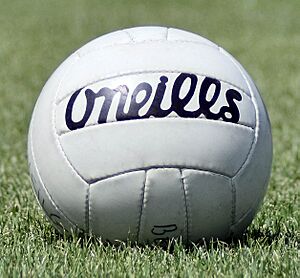
Gaelic football is played with a round leather football. It's made of 18 stitched leather panels, looking a bit like a traditional volleyball but larger. It's about 68 to 70 cm (27 to 28 in) around and weighs between 480 and 500 g (17 and 18 oz) when dry. Players can kick the ball or "hand pass" it. A hand pass isn't a punch; it's hitting the ball with the side of a closed fist, using the knuckle of the thumb.
Rugby Football Balls
Before 1870, rugby was played with a nearly round ball that had a pig's bladder inside. In 1870, Richard Lindon and Bernardo Solano started making balls for Rugby school. They used hand-stitched, four-panel leather covers with pig bladders. The unique oval shape of the rugby ball is thought to come from the pig's bladder, though early balls were more plum-shaped than oval. The size of the balls varied depending on the size of the pig's bladder. Because rubber is flexible, the shape slowly changed from a sphere to an egg. In 1892, the RFU made the oval shape a rule. The ball continued to become flatter over the years.
At first, synthetic (man-made) footballs were used in rugby only when the weather was wet. This was because they wouldn't soak up water and get heavy like leather balls. Eventually, leather balls were completely replaced by synthetic ones.
Rugby League Balls
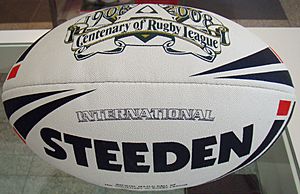
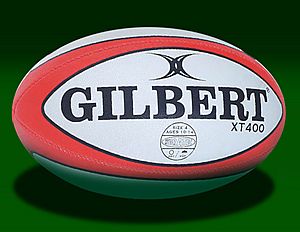
Rugby league uses an oval-shaped football filled with air. A referee will stop the game if the ball isn't the right size and shape. Traditionally, these balls were made of brown leather, but modern ones are synthetic and come in many colors and patterns. For senior games, light-colored balls are used so fans can see them better. A full-size rugby league ball is called "international size" or "size 5." It's about 27 cm (11 in) long and 60 cm (24 in) around its widest part. Smaller balls are used for younger players. A full-size ball weighs between 383 and 440 g (13.5 and 15.5 oz). Rugby league footballs are a bit more pointed than rugby union balls and larger than American footballs.
The National Rugby League in Australasia and the Super League use balls made by Steeden. In Australia, "Steeden" is sometimes used to mean the ball itself.
Rugby Union Balls
The ball used in rugby union is usually called a rugby ball. It's an oval shape, like an ellipse when you look at it from the side. Like rugby league balls, they were traditionally brown leather but are now made in many colors and designs. A regulation rugby union ball is 28 to 30 cm (11 to 12 in) long and 58 to 62 cm (23 to 24 in) around its widest point. It weighs 410 to 460 g (14 to 16 oz) and is inflated to a pressure of 65.7 to 68.8 kPa (9.53 to 9.98 psi).
In 1980, leather balls, which would get heavy when wet, were replaced with balls covered in synthetic waterproof materials. The Gilbert Synergie was the official match ball for the 2007 Rugby World Cup.
Images for kids
-
American football ball
-
Canadian football ball



